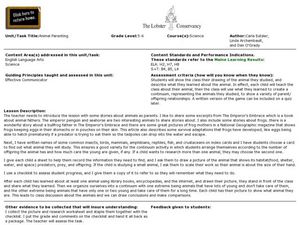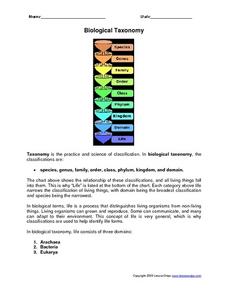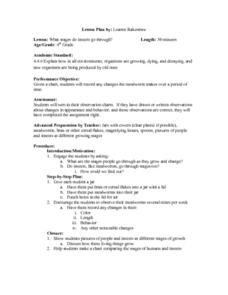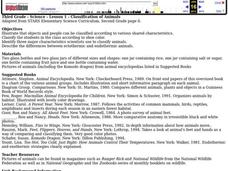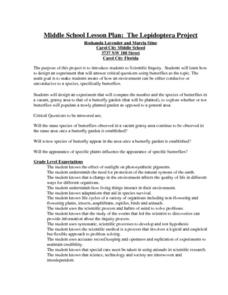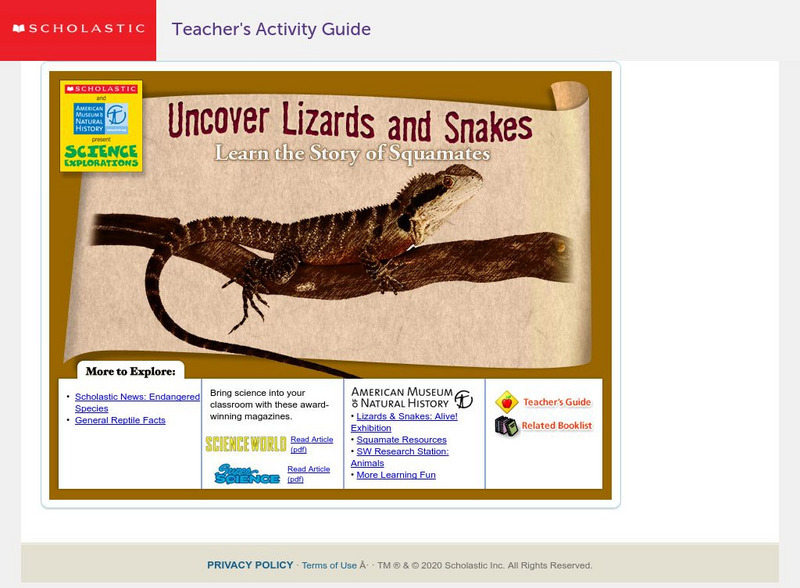Curated OER
Animal Parenting
Students analyze parenting instincts. In this parenting instincts instructional activity, students view a drawing of animal they studies and describe what they learned about the animal. Students teach the class about their animal and the...
Curated OER
Comparing Two Turtles
Students compare and contrast the various observable features of two different turtles. in groups, they complete a visual analysis of the sea turtle and tortoise. Using their observations, they complete Venn Diagram of the observable...
Curated OER
Biological Taxonomy
For this biology worksheet, students read about biological taxonomy. They then use the information they learned to answer the 13 questions on the worksheet. The answers are on the last page of the packet.
Curated OER
Birds of Wisconsin
First graders explore the job done by ornithologists. They role play identifying the characteristics that make a bird a bird. They discuss what makes each bird species unique. Students are introduced to Wisconsin's most common and rare...
Curated OER
What Stages Do Insects Go Through?
Fourth graders observe mealworms over a period of time and record any changes they observe. They record any changes in color, length, behavior, and any other noticeable changes, identify the stages of the mealworms, and create a chart...
Curated OER
Classification of Animals
Third graders practice classiyfying items and identify three major characteristics scientists use to classify animals. They describe the differences between ectothermic and endothermic animals.
Curated OER
Venom!
Students examine the nature of venom. They conduct an experiment to demonstrate how proteins such as venoms can be denatured using raw eggs, beakers, heated water, and compresses.
Curated OER
Surviving in Our Ecosystems
Third graders identify the characteristics of a frog and compare them to a human child. They draw and describe the best environment for a human to live in and the best environment for a frog to live in based on their physical...
Curated OER
Tropical Herpefauna
Students explore tropical herpefauna. They discuss the story "Tropical Herpefauna...Tropical What?" by Lori Bruckeim. Students discuss any concepts of the essay that need clarification and they predict, visualize, question, and summarize.
Curated OER
The Lepidoptera Project
Students are introduced to Scientific Inquiry and discover how to design an experiment that answers critical questions using butterflies as the topic. They design experiments that compare the number of species of butterflies in a vacant,...
Curated OER
Biology and the Digital Atlas
Students participate in a scavenger hunt on the internet. Using a digital atlas, they find answers to specific questions related to plants found in Idaho. To end the lesson, they share their results to the class to discover what happens...
Curated OER
Wildlife Habitat
Students explain what a habitat is and describe its four elements. They see how an area's habitat suitability varies with different species of wildlife. They name factors that affect habitat suitability.
Encyclopedia of Earth
Encyclopedia of Earth: Adaptations of Desert Amphibians and Reptiles
The evolution of amphibians from prehistoric days is described, and the challenges they face when living in a desert environment, of which the ability to reproduce is the greatest. How they manage to survive in a desert is explained in...
CK-12 Foundation
Ck 12: Life Science: Amphibians
[Free Registration/Login may be required to access all resource tools.] Amphibians are a group of vertebrates that have adapted to live in both water and on land. Amphibian larvae are born and live in water, and they breathe using gills....
Exploratorium
Exploratorium: The Amazing Adaptable Frog
Journey back over a million years ago and see how the common frog has adapted and changed.
Scholastic
Scholastic: Science Explorations: Uncover Lizards and Snakes
An exploration of squamates, or scaled reptiles. Take notes about lizards and snakes using the pdf "Squamate Chart" while viewing a slideshow, investigate the squamate anatomy and how squamates differ from other animals, such as insects...
Exploratorium
Exploratorium: Frogs, a Disappearing Act
At this site students can read about how frogs camouflage to avoid predators. There is an interactive exhibit too! (Must have the Shockwave plug-in to see animation.)
University of Southern California
Structure of Matter: Animals
A slide show that demonstrates the development of physical structure in the animal world, moving from sponges through mammals.
Smithsonian Institution
Smithsonian National Zoo: Meet Our Animals
This site from the National Zoological Park provides extensive information about many types of animals. Just click on the category you need. Includes pictures and live web cams.
Utah Education Network
Uen: Science Vocabulary Game
Fourth graders will play a review memory game with Utah's Grade 4 Science Standard V vocabulary words during this lesson plan. Words associated with living things and classifications of living things are included in this lesson plan.
National Health Museum
Access Excellence: Mystery Spot: Croak
Access Excellence provides this fictional interactive story that explores the possible reasons for a disappearing species of frogs. Follow the clues, and email your answer!
Curated OER
Frozen Wood Frog
This site describes how slimy amphibians crawled and swam on the Earth 190 million years ago. They have adapted in many different ways to become the way they are today. Use this site for more information about amphibians.
